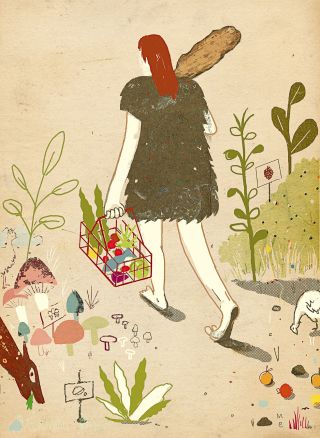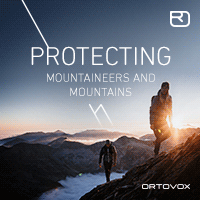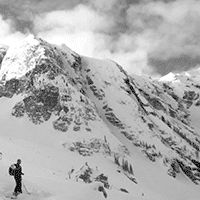How the Paleolithic Diet Got Trendy
It is an understatement to say that the Paleo diet is popular, from Crossfit gyms to steeply priced pseudo coconut tortillas; many athletes have readily implemented the diet into their lifestyle. However, when eating Paleo, are you still eating green? The New Yorker explores how the Paleothilic Diet became trendy, contrasting different opinions on the diet, our food evolution and the ingredients of a elementary paleo pack lunched.

The first day I put my family on a Paleolithic diet, I made my kids fried eggs and sausage for breakfast. If they were still hungry, I told them, they could help themselves to more sausage, but they were not allowed to grab a slice of bread, or toast an English muffin, or pour themselves a bowl of cereal. This represented a reversal of the usual strictures, and they were happy to oblige. It was like some weird, unexpected holiday—Passover in July.
The Paleolithic diet—“paleo,” for those in the know—represents a new, very old form of eating, one confined to the sorts of food available in pre-agricultural days. These foods, as it happens, were not many. According to Sarah Ballantyne, the author of “The Paleo Approach,” a paleo diet consists of “meats, fish, eggs, vegetables, fruits, nuts, and seeds.” According to John Durant, the author of “The Paleo Manifesto,” even seeds are suspect and should be avoided. (A genuinely Paleolithic diet, Durant concedes, probably ought to include human flesh; however, he does not advise this.)
The list of foods that are not paleo, meanwhile, is a great deal longer; it includes cereal grains like wheat, corn, and rice; pseudo-cereal grains like amaranth and quinoa; legumes, dairy products, most vegetable oils, sugar, and anything that contains corn syrup or artificial coloring or flavorings or preservatives, which is to say, just about everything a contemporary American consumes. Most days, my kids pack their own lunches, but since I had banned the standard ingredients, starting with the bread for peanut-butter-and-jelly sandwiches, I figured I was obligated to step in. I rolled up some turkey slices and arranged them in a plastic container with some cut-up avocados. Then I gave each kid a banana and some paleo “cookies” I had made using ground-up almonds. The cookies looked like little hamburgers and tasted like sawdust.
There are, of course, lots of ways to resist progress. People take up knitting or quilting or calligraphy. They bake their own bread or brew their own beer or sew their own clothes using felt they have fashioned out of wet wool and dish soap. But, both in the scale of its ambition and in the scope of its anachronism, paleo eating takes things to a whole new level. Our Stone Age ancestors left behind no menus or cookbooks. To figure out what they ate, we have to dig up their bones and study the wear patterns on their teeth. Or comb through their refuse and analyze their prehistoric poop. And paleo eating is just the tip of the spear, so to speak. There are passionate advocates for paleo fitness, which starts with tossing out your sneakers. There’s a paleo sleep contingent, which recommends blackout curtains, amber-tinted glasses, and getting rid of your mattress; and there are champions of primal parenting, which may or may not include eating your baby’s placenta. There are even signs of a paleo hygiene movement: coat yourself with bacteria and say goodbye to soap and shampoo.
The result is a small library of what might be called paleo literature—how-to books that are mostly how-to-undo books. Such is the tenor of our time that the ultimate retro movement is lavishly represented on the Web. From a site called Paleo Grubs, I downloaded recipes for Delicious Paleo Carrot Cake Muffins and Paleo Apple Nachos, and from a site called Nom Nom Paleo I got instructions on how to make Paleo Krabby Patties and Civilized Caveman’s Apple Cinnamon Cookies. (All of these dishes rely heavily on ingredients—including “flour”—made from coconuts, a quirk that reminded me of “Gilligan’s Island” and its many coconut-shell contraptions.)
Three days into my family’s experiment in Stone Age eating, my sons were still happily gorging themselves on sausage and grass-fed steak. My husband was ruminating on the tenuousness of existence, and, probably true to the actual Paleolithic experience, I found that I was spending more and more time preparing the few foods that we could eat.
Agriculture was “invented” several times, in different parts of the world, by people making use of the plants they found growing wild around them. The first time was probably about ten thousand years ago, in southeastern Turkey, when early farmers began cultivating einkorn wheat. The crop was a big hit, and, at least by the standards of the day, it spread rapidly. (This is sometimes referred to as the Big Agricultural Bang.) Wheat was being sown in Greece around eight thousand years ago, in the Balkans and in Italy seven thousand years ago, and in India and Scandinavia five thousand years ago. Meanwhile, around nine thousand years ago, a group of proto-farmers in southwestern Mexico began cultivating maize. It, too, quickly caught on, and was being grown in Panama seven thousand years ago and in Colombia six thousand years ago. Also sometime around nine thousand years ago, rice was domesticated in the Yangtze Valley.
In the standard account of human history, agriculture represents the ur-breakthrough. The domestication of plants and animals allowed people for the first time to build up surpluses of food. This, in turn, allowed them to think about something besides feeding themselves. They became merchants and priests and artisans and bookkeepers. They built villages, towns, and cities. Every subsequent innovation—metallurgy, writing, mathematics, science, and even paleo Web sites—could be said to owe its origin to those first farmers scratching with sticks in the dirt.
Agro-revisionists also regard the Neolithic Revolution as a critical event. They, too, believe that without it modern society wouldn’t exist. What they’re not so sure about is whether it was a good idea.
“The adoption of agriculture, supposedly our most decisive step toward a better life, was in many ways a catastrophe from which we have never recovered” is Jared Diamond’s dour assessment, offered in an essay titled “The Worst Mistake in the History of the Human Race.”
Like Stone Age hunter-gatherers, early farmers left little behind—just some burnt grain, mud foundations, and their own bones. But that’s enough to reveal how punishing the transition to agriculture was. According to a study of human remains from China and Japan, the height of the average person declined by more than three inches during the millennia in which rice cultivation intensified. According to another study, of bones from Mesoamerica, women’s heights dropped by three inches and men’s by two inches as farming spread. A recent survey of more than twenty studies on this subject, published in the journal Economics and Human Biology, found that the adoption of agriculture “was observed to decrease stature in populations from across the entire globe,” including in Europe, the Middle East, Asia, and South America.
Early farmers were not just shorter than hunter-gatherers; they were also more sickly. They had worse teeth—one analysis from the Near East suggests that the incidence of cavities jumped sixfold as people started relying on grain—and they suffered from increased rates of anemia and infectious disease. Many now familiar infections—measles, for instance—require high population densities to persist; thus, it wasn’t until people established towns and cities that such “crowd epidemic diseases” could flourish. And, by living in close proximity to their equally crowded farm animals, early agriculturalists helped to bring into being a whole set of diseases that jumped from livestock to people.
“The adoption of agriculture,” Diamond notes in his most recent book, “The World Until Yesterday,” provided “ideal conditions for the rapid transmission of microbes.” According to Daniel E. Lieberman, a professor of evolutionary biology at Harvard and the author of “The Story of the Human Body,” “farming ushered in an era of epidemics, including tuberculosis, leprosy, syphilis, plague, smallpox and influenza.”
It took thousands of years for human bodies to recover; Lieberman reports that “it wasn’t until the twentieth century that Europeans were the same height as cavemen.” And, almost as soon as the stature gap closed, new problems arose. People began to grow not just taller but also wider. During the past several decades, rates of obesity, hypertension, fatty-liver disease, and Type 2 diabetes have soared. The increases were first noted in the United States, but, now that French fries and Coke have gone global, nations ranging from Mexico to Mauritius have seen similar—indeed, in some cases, worse—surges. Today, the highest prevalence of diabetes is in Tokelau, a territory of New Zealand in the South Pacific, where nearly forty per cent of adults are afflicted. Lieberman calls conditions like Type 2 diabetes “mismatch diseases.” Our ancestors hunted and gathered; we drive to Shake Shack and Domino’s. The result is a “mismatch” between our genetics and our life styles.
“I don’t think it is possible to overemphasize just how important mismatch diseases are,” Lieberman writes. “You are most likely going to die from a mismatch disease.”
Paleo may look like a food fad, and yet you could argue that it’s really just the reverse. Anatomically modern humans have, after all, been around for about two hundred thousand years. The genus Homo goes back another two million years or so. On the timescale of evolutionary history, it’s agriculture that’s the fad.
During our week of paleo, I made several trips to the nearest Stop & Shop, a hangar-size affair that sells something like forty thousand different items. In the store’s vast midsection, which is given over to processed confections, there’s aisle after aisle of salty snacks, soft drinks, sports drinks, and breakfast cereals, followed by more aisles of sugary snacks, candy bars, packages of multiple candy bars, and cookies. One afternoon, as I was pushing my cart along, searching for shredded coconut, it occurred to me that my Paleolithic ancestors would have had a hard time recognizing anything in these rows as food.
Probably they would have had an easier time over in the produce section, but here, too, they would have found plenty to baffle them. What we know as apples, from the tree Malus domestica, are the products of hundreds of generations of careful breeding that started with the tree Malus sieversii, native to Central Asia. The author Michael Pollan once described the fruit of Malus sieversii as tasting like “a tart potato,” or, alternatively, like a “Brazil nut sheathed in leather.” Avocados, a staple of many paleo menus, have similarly been transfigured. The originals consisted of just a thin layer of flesh surrounding a giant seed.
And what goes for apples and avocados also goes for broccoli, bananas, and Brussels sprouts. (It’s also probably true of coconuts, though by now domesticated coconut palms have been so widely cultivated that there are hardly any truly wild ones left.) Similarly, the meat cases in our supermarkets are stacked with bits and pieces of animals reshaped by human appetites. Beef cattle—and dairy cows, too—are descended from aurochs, which were much larger and fiercer animals. Aurochs, for their part, are no longer to be had for the same reason that moas, mammoths, and mastodons are unavailable: our ancestors hunted them to oblivion. As Marlene Zuk, a biologist at the University of Minnesota, puts it in her book “Paleofantasy: What Evolution Really Tells Us About Sex, Diet, and How We Live,” “The reality is that we are not eating what our ancestors ate, perhaps because we do not want to, but also because we can’t.”
Paleo practitioners are well aware of this fact. The diet, they say, is not meant to replicate so much as to translate, and, just as we wouldn’t expect an English version of the Iliad to be rendered in dactylic hexameter, we shouldn’t expect paleo dieters to run down game or dig up and consume grubs.
“Eating a Paleolithic diet is not about historical re-enactment,” Durant writes in “The Paleo Manifesto.” “It is about mimicking the effect of such a diet on the metabolism with foods available at the supermarket.” According to this way of thinking, our metabolism was designed to deal with foods that approximate aurochs and wild avocados. It wasn’t designed to deal with toast.
In promoting red meat and rejecting grains, the paleo diet challenges just about every precept that nutritionists have been pushing for the past fifty years. In effect, it turns the familiar food pyramid on its point. This is an increasingly common inversion, if not in academic circles or at the U.S. Department of Agriculture then on the talk-show circuit. In his wildly popular manifesto-cum-recipe book, “Grain Brain,” David Perlmutter, a Naples, Florida, neurologist, maintains that sandwiches are not just hard on the digestive system; they wreak havoc on the mind.
“Modern grains are silently destroying your brain,” he writes. “Basically, I am calling what is arguably our most beloved dietary staple a terrorist group.” In “The Big Fat Surprise,” Nina Teicholz, a New York-based journalist, rises in defense of lard. She advises readers to “eat butter; drink milk whole, and feed it to the whole family. Stock up on creamy cheeses, offal, and sausage, and yes, bacon.”
Though the paleos, the anti-glutenists, and the lard-ons are not exactly anti-vaccination or Area 51 types, they are, by necessity, conspiracy theorists. There must be some reason that the U.S. government has kept the dark truth about spelt and tofu hidden from us. Durant blames “the vegetarian lobby.” Teicholz suspects “olive oil money.”
For almost as long as people have been eating, they’ve been imposing rules about what can and can’t be consumed. In tribes or clans with totem animals, the totem is off limits. The Jews have the laws of kashruth, which, in addition to disallowing pork and shellfish, also forbid the consumption of reptiles, amphibians, and most kinds of insects (though there are some species of kosher locusts). Islamic dietary law divides foods into halal and haram; to the latter category belong pork, dog, cat, and monkey. Hindus do not eat beef, and many eat no meat at all. The Moru of South Sudan allow only children and old people to eat chicken and eggs, and some groups of Cushitic people in northeastern Africa avoid fish. (“Speak not to me with a mouth that eats fish” is a taunt recorded in Somalia by the nineteenth-century British explorer Richard Francis Burton.) The Yazidis, a group of ethnic Kurds who live mainly in Iraq, will not eat lettuce, and Jains eat no onions or root vegetables.
“Food taboos are known from virtually all human societies,” a survey that ran a few years ago in the Journal of Ethnobiology and Ethnomedicine observed. Such taboos must fulfill some deep—you might even say primal—human need. And this may be the best way to understand the paleo diet: as a set of food prohibitions for the Internet age.
Both on their Web sites (which usually offer an array of “transformational” products for sale) and in their many, many guidebooks (“Paleo for Beginners,” “Practical Paleo,” “Your Personal Paleo Code”), proponents of the paleo diet make all sorts of claims for its efficacy. Some contend that it cures autoimmune diseases, others that it reverses diabetes. Durant maintains that it cleared up his acne. “I used to nearly always get a gigantic zit right on the same area of my nose,” he writes. The most common assertion is that it’s good for losing weight, which I can believe. I spent most of my week on a paleo diet feeling as if I’d swallowed a wildebeest. Meanwhile, nearly every paleo dish I prepared, beyond straight-up meat and vegetables, was a flop. An attempt at pancakes ended up mostly in the compost, as did a batch of muffins. (As the Professor discovered, there’s only so much you can do with coconuts.)
Paleo adepts will doubtless argue that a week is not enough to experience the diet’s full benefits, and that I did not approach the enterprise in the right spirit. I must confess that they are right.
The last time most of humanity followed, by necessity, a paleo diet, there were maybe five million people on the planet. Yet already they were having a big impact; it’s been theorized that one of the impetuses for the development of agriculture was that large, easy-to-kill prey were becoming harder to find. As grain-growing spread, it produced what’s been called the “first population explosion.” Farmers can wean their children at a much younger age than hunter-gatherers can—they have foods like porridge to feed them—and thus can produce new ones more quickly. As a result, the sicklier agriculturists were able to outbreed the more robust hunter-gatherers. More farmers then needed even more land, which further reduced the resources available to foragers.
Whether or not agriculture was the “worst mistake in the history of the human race,” the choice, once made, was made for good. With a global population of seven billion people, heading rapidly toward eight billion, there’s certainly no turning back now (even if paleo does, in fact, prevent zits). Pound for pound, beef production demands at least ten times as much water as wheat production, and, calorie for calorie, it demands almost twenty times as much energy. Livestock are major sources of greenhouse-gas emissions, not just because of the fuel it takes to raise them but also because they do things like belch out methane and produce lots of shit, which in turn produces lots of nitrous oxide. One analysis, published in the American Journal of Clinical Nutrition, concluded that, in terms of emissions, eating a pound of beef is the equivalent of driving forty-five miles. (Grass-fed beef—recommended by many primal enthusiasts—may produce lower emissions than corn-fed, but the evidence on this is shaky.) Eating a pound of whole wheat, by contrast, is like driving less than a mile. All of which is to say that, from an environmental standpoint, paleo’s “Let them eat steak” approach is a disaster.
With this in mind, I decided that I would cook liver for my family’s last paleo supper. In spite of the week’s culinary missteps, my sons seemed to be taking all too well to carnivory, and I thought perhaps a serving of offal—another favored paleo food group—might set them straight. They devoured it cheerfully. The next day, I asked them what they’d learned from the week’s experiment.
“We should eat more liver,” one of them said. ♦
Article from the 7/28/2014 issue of New Yoker Magazine in the Stone Soup section
newyorker.com







